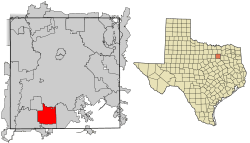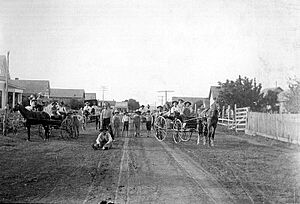DeSoto, Texas facts for kids
Quick facts for kids
DeSoto, Texas
|
|||
|---|---|---|---|
| City of DeSoto | |||
|
|||
| Motto(s):
"Live, Work, Play in DeSoto"
|
|||

Location of DeSoto in Dallas County, Texas
|
|||
| Country | |||
| State | |||
| County | |||
| Incorporated | 1949 | ||
| Government | |||
| • Type | Council-manager | ||
| Area | |||
| • Total | 21.67 sq mi (56.12 km2) | ||
| • Land | 21.63 sq mi (56.03 km2) | ||
| • Water | 0.03 sq mi (0.09 km2) | ||
| Elevation | 666 ft (203 m) | ||
| Population
(2020)
|
|||
| • Total | 56,145 | ||
| • Density | 2,595.34/sq mi (1,002.07/km2) | ||
| Time zone | UTC-6 (Central) | ||
| • Summer (DST) | UTC-5 (Central) | ||
| ZIP codes |
75115, 75123
|
||
| Area code(s) | 214, 469, 945, 972 | ||
| FIPS code | 48-20092 | ||
| GNIS feature ID | 2410329 | ||
| Website | The City of DeSoto, Texas | ||
DeSoto is a city in Dallas County, Texas, United States. It's a suburb of Dallas. DeSoto is part of the "Best Southwest" area. This area also includes the cities of Cedar Hill, Duncanville, and Lancaster.
Contents
History of DeSoto
Early Days and Naming
The area where DeSoto is located was first settled in 1847. This makes it one of the oldest communities in North Texas. A post office opened in 1881. The settlement was named DeSoto to honor Dr. Thomas Hernando DeSoto Stewart. He was a doctor who cared a lot about the community.
By 1885, DeSoto had about 120 people. It also had a cotton gin and a general store. After a while, the population dropped to fewer than 50 people. In 1930, 97 people lived in the community. There were also several businesses.
Becoming a City
After World War II, DeSoto and the areas around it started to grow. People wanted to make the town an official city. This would help them improve things like the water system. On February 17, 1949, 42 voters asked for an election. They wanted to vote on making DeSoto a city.
The vote happened on March 2. Out of 52 people who voted, 50 said yes. Only two people voted no. On March 3, 1949, DeSoto officially became a city. The new city was less than one square mile in size. On March 15, Wayne A. Chowning was elected as the first mayor. Five other people were elected as aldermen (city council members). Their first city council meeting was held two days later.
Growth and Development
The first count of people after DeSoto became a city was in 1950. There were 298 people and eight businesses. In 1953, the city grew bigger by adding more land. It became about 15 square miles. By 1960, the population had grown to 1,969 people. In 1970, DeSoto was home to 6,617 people and 71 businesses.
During the 1970s, the city kept growing. This led to better roads and a new water and sewage system. More homes, businesses, and factories were built. In 1974, a small community called Woodland Hills joined DeSoto. This helped the city grow even more. By 1980, the city's population was over 15,000. By 1984, DeSoto had 360 businesses. This was a big jump from 168 businesses in 1980.
Modern DeSoto
The population went over 30,000 in 1990. The city continued to develop. A great example of this was the creation of DeSoto's Town Center. City leaders turned an old shopping center into a special downtown area. Since it opened, the Town Center has become a very important part of the community. It has the city hall, the public library, a civic center, and a recreation center. It also has an auditorium and an outdoor amphitheater.
Throughout the 1990s, DeSoto became home to people from many different backgrounds. The city became more diverse. By 2005, DeSoto had about 45,500 residents. It was the largest and most diverse city in southwest Dallas County.
On June 11, 2006, DeSoto received a special award. The National Civic League named it an "All-America City." This award is given to communities where people work together. They solve problems and achieve great things. In 2015, an article noted that many middle-class and educated African Americans were choosing to move to DeSoto.
Geography
DeSoto covers about 21.6 square miles. All of this area is land.
Population
As of the 2020 United States census, DeSoto had 56,145 people.
Education
Most of DeSoto is part of the DeSoto Independent School District. This school district has 12 schools. These include seven elementary schools, three middle schools, and a high school. There is also a freshman campus for new high school students. About 8,000 students attend these schools. The district's mascot is the eagle.
A small part of DeSoto is in the Duncanville Independent School District. Another small part is in the Dallas Independent School District.
Students who live in Dallas County can attend Dallas College. There are also several private and parochial schools nearby.
Media
The Focus Daily News is a newspaper published in DeSoto. It covers news in Dallas County.
Transportation
Major Highways

 Interstate 35E/U.S. Route 77
Interstate 35E/U.S. Route 77
Air Travel
The city of DeSoto owns the DeSoto Heliport. This is a place where helicopters can land and take off. The heliport is operated by SKY Helicopters.
See also
 In Spanish: DeSoto (Texas) para niños
In Spanish: DeSoto (Texas) para niños




